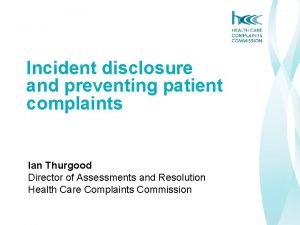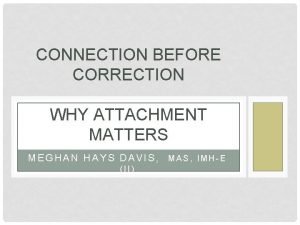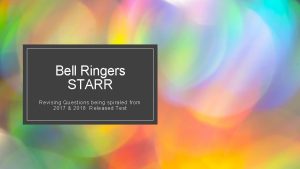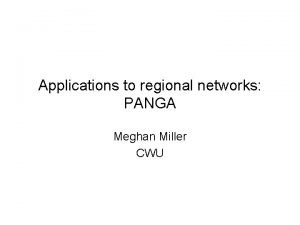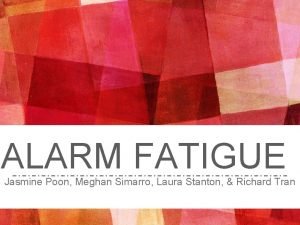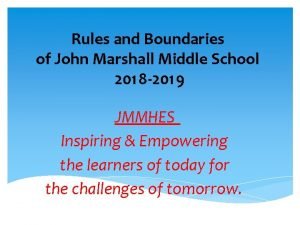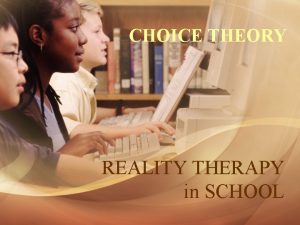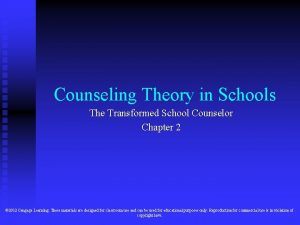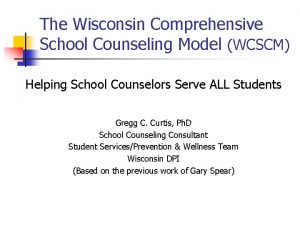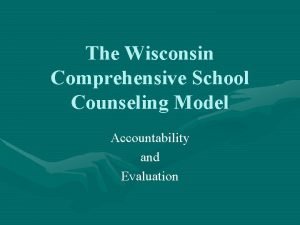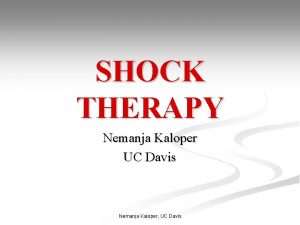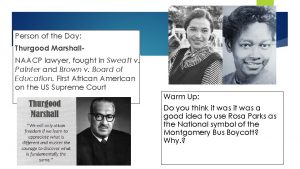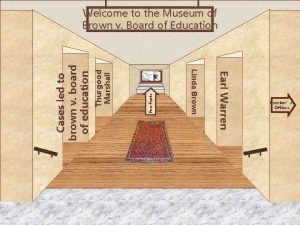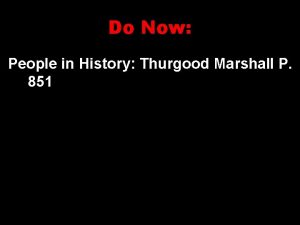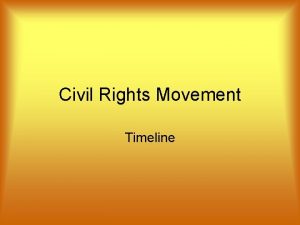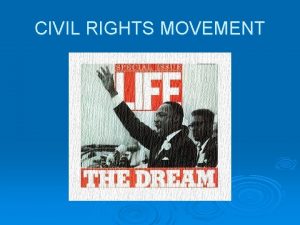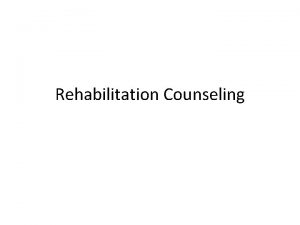School Counseling at Thurgood Marshall Meghan Kaloper MA





























- Slides: 29

School Counseling at Thurgood Marshall Meghan Kaloper, MA Ed. , NCC

Delivery of Service � Individual Counseling ◦ Red: Responsive Services ◦ Emotion management support ◦ Family change: divorce, death � Small Group Counseling ◦ Yellow: Early Intervention � Classroom Guidance Lessons/Skill Practice & School-Wide Initiatives. Consultation & Collaboration. ◦ Green: Preventive Care/ Early Intervention

Additional Programs � Conflict Mediator Program ◦ 4 th and 5 th grade students actively assist younger peers in solving conflicts. � Recess Mentor Program ◦ 4 th and 5 th graders engage younger students in play. Mentors model positive behaviors, help students stay safe, and help kids connect in group games.

School-Wide Initiatives � Buddy Bench- let your kids know about it! � Wheel of Choice � Taproot Theatre Anti-Bullying Performances

Family Supports � Family Consultation/Collaboration: ◦ Meetings (Tuesday-Thursday) ◦ Phone meetings (Tuesday-Thursday) ◦ E-mail � Referral � Book to Outside Counseling & Resources & Activity Suggestions ◦ For students ◦ For families

Positive Discipline �A ◦ ◦ ◦ school-wide framework. Positive Discipline is: Kind but Firm (respectful and encouraging) Helps kids feel a sense of Belonging and Significance Is Effective Long Term (non-punitive) Teaches Social and Life Skills for positive character Invites children to discover how Capable they are � Solution-Focused � Encouraging � Mutual Respect

• • • Evidence-based approach to social and emotional learning Helps school communities integrate the teaching and practice of emotional intelligence into daily life Trains everyone beginning with the adults Reduces problem behavior and enhances academic achievement Watch SPS short video: http: //tiny. cc/RULERintro

Anchor Tools

WHAT IS EMOTIONAL INTELLIGENCE? � Emotional intelligence has five key skills:

Charter � � � Helps enhance school climate and community well-being through establishing common goals and a shared vision Created by the community (the classroom or the family)- everyone should be part of the process Clearly and specifically outlines what is needed to build a supportive and productive environment Shared accountability for behaviors and reduces unkind behaviors Charters are living documents!

Family Charter �How do you want to feel at home? �What behaviors help make those feelings? What can you do each day to make sure that everyone experiences those feelings? Be specific! �How should we prevent and manage unwanted feelings/conflict? � Let’s Share! Does anyone have a Family Charter or something similar? � Would a Family Charter be helpful? � Sample template: http: //www. greatschools. org/gk/wpcontent/uploads/2015/06/Yale_Family_Charter. pdf �

Mood Meter � Increases self awareness, emotion regulation, and communication about feelings � Expands feeling vocabulary � Energy and Pleasantness (Low and High) � No such thing as a “bad” emotion

Mood Meter Check In 2. Understand: What caused you to feel this way? 3. Label: What word best describes your feeling? ENERGY 1. Recognize: Where are you on the Mood Meter? 4. Express: How are you expressing this feeling? 5. Regulate: Is this feeling helpful right now? What strategy will you use to feel more, less, or the same? PLEASANTNESS

Family Mood Meter � Let’s Share! Who uses the Mood Meter at home? How do you share or talk about feelings? How might you utilize the Mood Meter? What thought or action strategies do you have for regulating or changing your emotions? ◦ How might this tool be helpful? ◦ ◦

MOODMETERAPP. com

Meta Moment � � � Helps students handle strong emotions so that they can make better decisions It is a brief ‘step-back’ from the situation Teaches students to pause and think before acting and consider how their ‘best self’ would react in the situation

Meta Moments at Home � Share out! ◦ Does anyone use Meta Moments at home? ◦ Does anyone use something similar during a triggering moment? ◦ How might this be helpful? ◦ What thought or action strategies do your children have for calming down?

Blueprint � Problem Solving � Perspective taking � Empathy building

BLUEPRINT: 10 Ways to De-escalate Conflict 1. Remain calm. 2. Respect personal space. 3. Ask person to share what they are experiencing with open-ended questions. 4. Empathize with feelings. 5. Give choices and alternative behaviors instead of telling them what to do. 6. Respond selectively and restate / clarify what the person says. 7. Ask about the facts instead of emotions. 8. Give them your undivided attention. 9. Allow for silence in the conversation. 10. Thank the person for their positive behavior afterwards. WORKBOOK PAGE 90 A

Practice with the Blueprint � � Scenario: Your child comes home from school and he/she is feeling very angry and left out by his/her closest friend Devin. Your child reports that at recess Devin said “You can’t play” when your child asked to join a game of tag. You know that when your child and Devin are in small arguments, they sometimes intentionally exclude each other to exert power. Yesterday was a day your child and Devin were in an argument over who could use the bean bag chair in their classroom. You know that yesterday during the beanbag conflict, your child said to Devin, “go away!! It’s mine!”. Work with a partner using the Blueprint. Imagine having a conversation with your child (after he/she has calmed down) using the Blueprint as a tool. Decide with your partner if you want to explore the incident at recess or the bean bag incident (or both!)

BLUEPRINT Debrief What did this activity teach us about emotions? 1. Emotions influence how we interact and respond to others. 2. Lots of emotions can occur in a short time period. 3. Past experiences (“baggage”) influence how we handle emotions. 4. We have “rules” about emotion at work/home/school. 5. There are better and worse strategies to handle our emotions.

Blueprint at Home � Share out! ◦ Who has used the Blueprint at home? ◦ What tools or strategies do you use to work though a problem? ◦ How might this be helpful?

Describing Language: How are you feeling? R: I can see your face looks______. How is your body feeling? -------U: What is causing you to feel this way? -----L: How are you feeling? ------E: Express: It’s OK to feel angry, but how can we show that in a safe and healthy way? -------R: What might help you feel better?

RULER while reading R U L E R Recognize How is he/she feeling? How do you know he/she is feeling this way? Understand What happened to make him/her feel that way? Label What is the name of this feeling? Express What is his/her face/body doing? Regulate What can he/she do to feel better?

RULER COMMUNITY RULER Community website: http: //rulercommunity. yale. edu/ Great Schools & Yale: http: //www. greatschools. org/gk/yale-tools-for-families/

When we feel better we do better! � What are you planning to try at home? � What additional support do you need to feel successful?

Success Stories? � We • • want to hear what you are doing! Challenges? Ideas? Suggestions? Tips?

Resources � Please grab a RULER packet before you leave! � Check the Counseling Department Web Link � Looking for something specific? ◦ Please contact me!

Contact Information � Meghan Kaloper � Office 120 (inside workroom) � Phone: (206) 252 -2808 � Email: mrkaloper@seattleschools. org � Web: http: //marshalles. seattleschools. org/services � Schedule: Tuesday, Wednesday, Thursday � Thank you! Questions?
 Thurgood marshall ducksters
Thurgood marshall ducksters Darius davis static shock
Darius davis static shock Ian thurgood
Ian thurgood Meghan biernacki
Meghan biernacki Naviance eanes
Naviance eanes Meghan vogel
Meghan vogel Meghan troup dalhousie
Meghan troup dalhousie Meghan miller unt
Meghan miller unt Stanton alarm system
Stanton alarm system Meghan imrie
Meghan imrie Meghan anzelc
Meghan anzelc Mn dream act
Mn dream act Meghan stasz
Meghan stasz John marshall middle school
John marshall middle school John marshall middle school houston
John marshall middle school houston George c marshall sports
George c marshall sports Lambert high school counselors
Lambert high school counselors Missouri guidance lessons
Missouri guidance lessons Program components
Program components Choice theory total behavior car
Choice theory total behavior car Naviance lowell
Naviance lowell Lambert graduation requirements
Lambert graduation requirements School counseling theory
School counseling theory Kell high school counseling
Kell high school counseling Issaquah high school counseling
Issaquah high school counseling Nyit school counseling
Nyit school counseling Wisconsin comprehensive school counseling model
Wisconsin comprehensive school counseling model Wisconsin comprehensive school counseling model
Wisconsin comprehensive school counseling model Lambert high school counselors
Lambert high school counselors Northville high school counseling
Northville high school counseling


